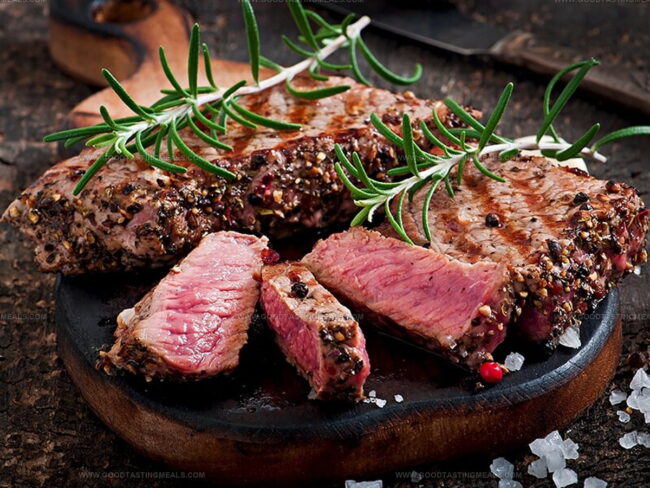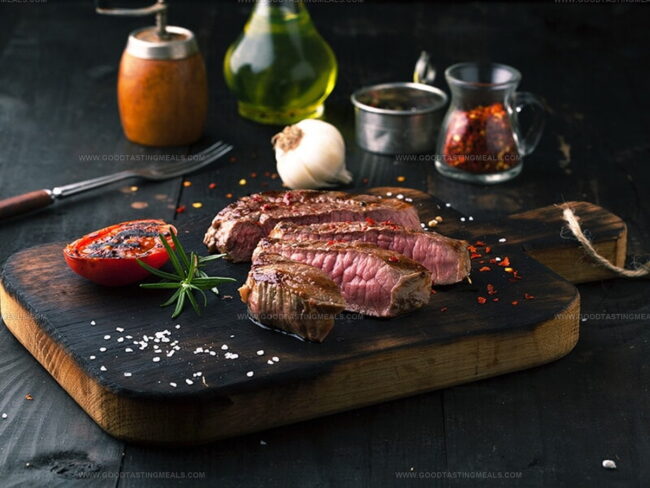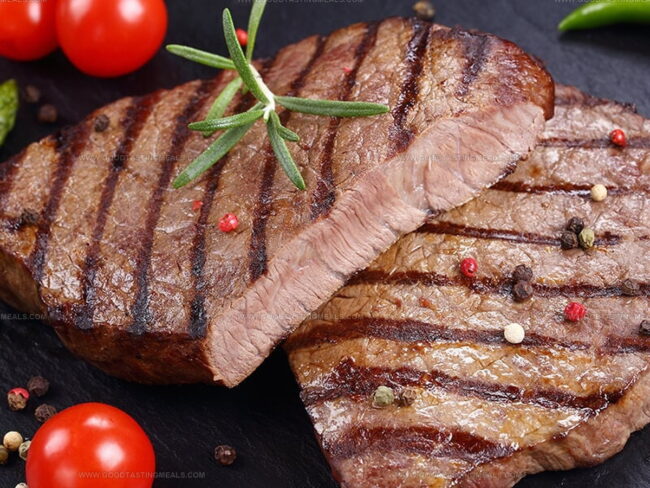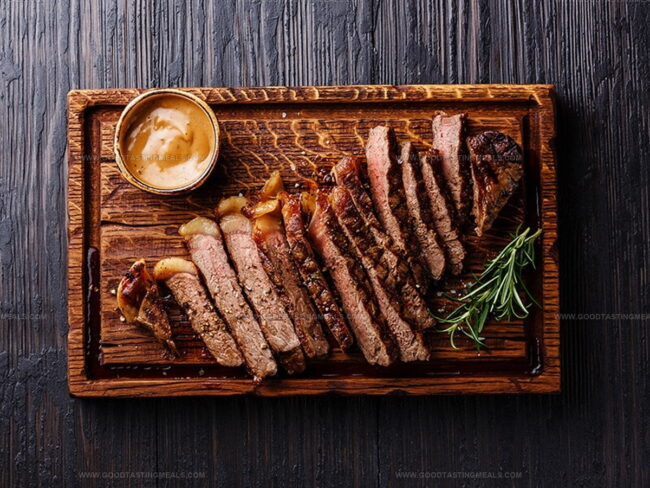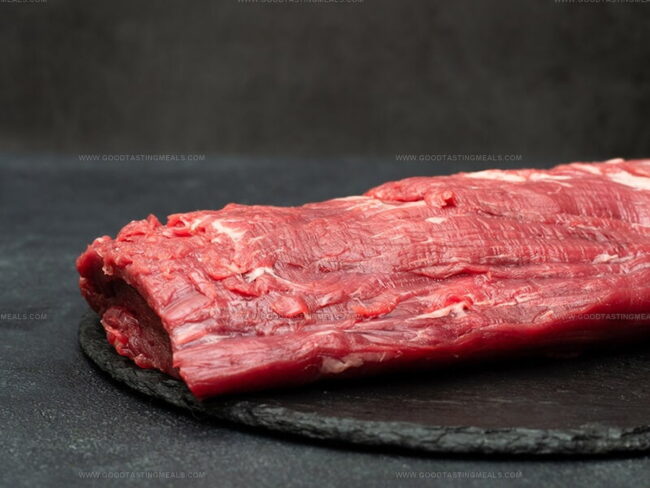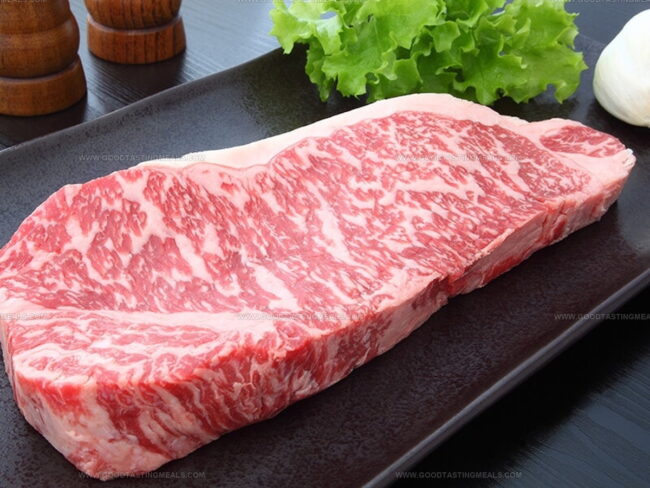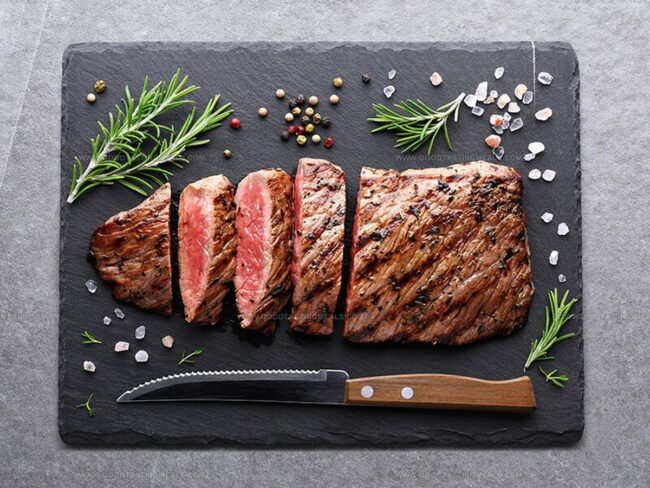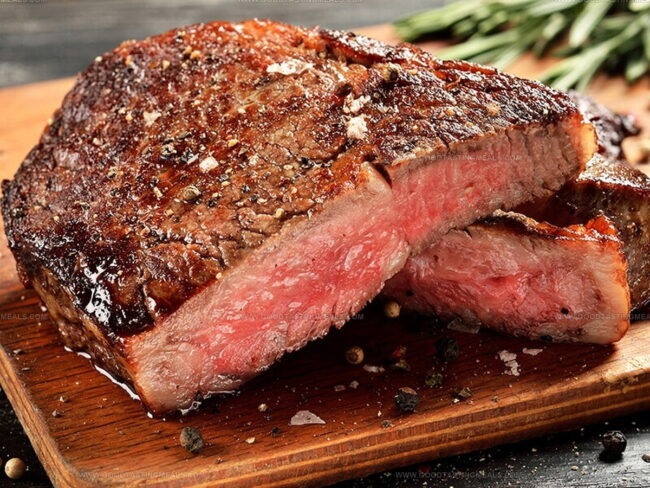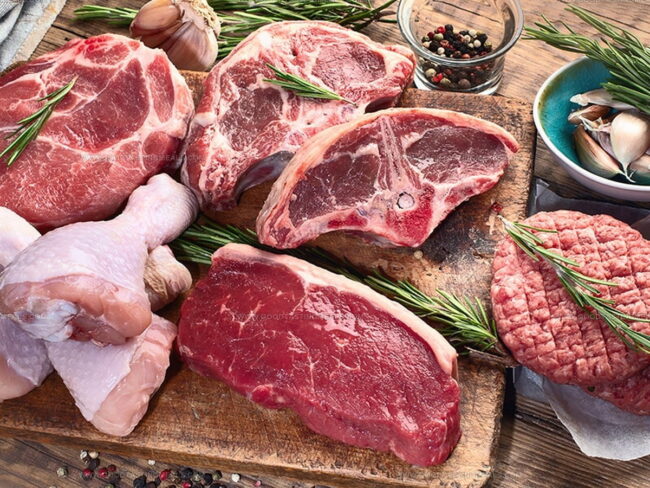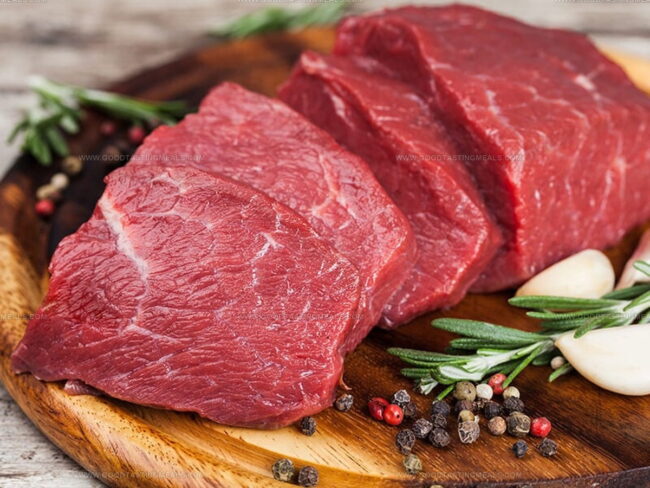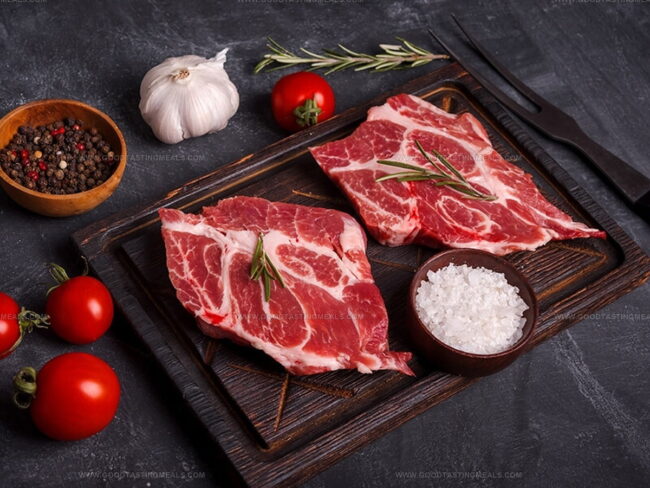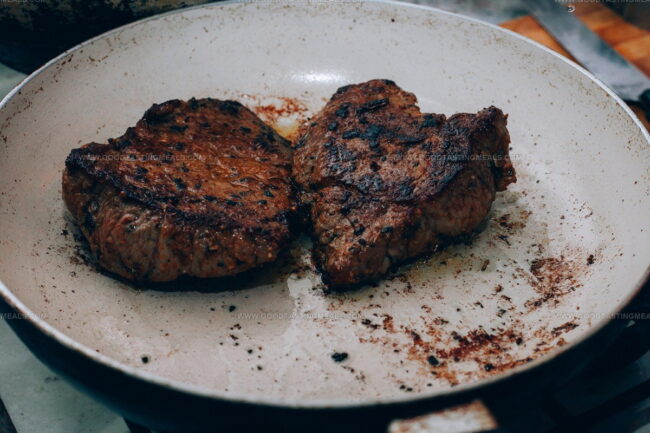Medium or Medium-Rare: Which Doneness Works Best?
Medium steak temperatures create quite the culinary debate at dinner tables worldwide.
Some diners prefer their meat pink in the center, while others want less redness showing through.
The distinct differences between medium and medium-rare cooking affect not just color but also texture and flavor profiles.
A perfectly cooked medium steak should display a warm pink center with more browning than its medium-rare counterpart.
This small temperature difference creates a significant change in dining experience that you can taste with each bite.
Exploring Steak Doneness: From Rare to Well-Done
Steak doneness falls into six distinct levels, with medium and medium-rare standing out as popular choices among meat lovers. Other options include blue-rare, rare, medium-well, and well-done, each representing a specific cooking temperature and time.
However, times may vary depending on steak thickness and cooking method.
Blue Rare
Blue rare steak is quickly seared on the outside, leaving the center almost raw and cool with a dark purple color. It offers a tender, buttery texture and a very pure beef flavor.
High heat creates a slight crust while preserving the raw interior. This style is best for high-quality cuts and those who enjoy minimal cooking.
Safety can be a concern due to the nearly raw center. It’s a delicacy for adventurous eaters.
Rare
Rare steak has a warm, red center with pink juices that are actually water and myoglobin, not blood. It’s tender and juicy with lightly charred edges.
This doneness works well with leaner cuts since fat doesn’t fully melt. It’s popular among those who want minimal cooking but still some developed flavor.
Rare balances softness with a bit of warmth.
Medium-Rare
Medium-rare is often considered the ideal doneness for steaks. It has a warm pink center with slight redness and juicy tenderness throughout.
The outside is nicely browned and flavorful due to proper searing. This level brings out the steak’s full flavor and tenderness without being too raw or too cooked.
Many chefs recommend medium-rare for the best steak experience.
Medium
Medium steaks have a brown crust with a warm pink center and no red spots inside. The texture is firmer with slight resistance, and juices stay mostly inside the meat.
It reaches safe cooking temperatures, reassuring many diners. Though slightly drier than rarer steaks, it offers a good balance of flavor and safety.
Medium is a common favorite for those cautious about undercooked meat. It’s hearty and flavorful without being too raw.
Medium-Well
Medium-well steaks are mostly brown inside with faint pink lines and less juice, resulting in a drier, firmer bite. This doneness is chosen for its safety and near-complete cooking.
Because it can be dry, it’s often served with sauces to add moisture and flavor. It suits those who want little to no redness but still some tenderness.
Medium-well steaks have a rich sear but less juiciness. It’s a practical choice for many.
Well-Done
Well-done steaks are fully cooked with no pink, resulting in a firm, chewy texture. They are often cooked slowly at low heat to avoid toughness.
The meat is dry with most moisture cooked out, leading to a milder beef flavor. Many skip this doneness due to dryness but appreciate its safety.
Well-done is perfect for those who dislike any rawness. It’s the safest and most cooked option.
Medium or Medium-Rare? Choose Your Ideal Steak Doneness
Medium and medium-rare steaks stand apart with their own special flavors and textures. Several key differences exist between these two cooking levels that matter when picking the perfect steak for dinner.
But first, take a quick glance at the table below for quick detailed breakdown.
| Aspect | Medium-Rare Steak | Medium Steak |
| Suitable Cuts | Lean, flavorful cuts like tenderloin, sirloin tip, ribeye with less fat | Cuts with higher fat and tenderness like T-bone, porterhouse, Wagyu, Kobe |
| Appearance | Pink center with reddish hints, browned outside; inner texture slightly undercooked | Mostly pink center (~25%), more browned and charred outside; no raw/red spots inside |
| Texture | Firm outside, soft and tender inside; juicy and buttery | Firmer and slightly chewier; less juicy due to longer cooking |
| Flavor | Juicy, moist, and rich natural beef flavor; more satisfying | Less juicy, drier; subtle reduction in flavor intensity due to more cooking |
| Cooking Time & Temp | Shorter cooking time; internal temp ~130-135°F | Longer cooking time; internal temp ~140-145°F |
| Ease of Preparation | Requires careful timing and thermometer to avoid undercooking | Slightly easier to achieve doneness; still needs thermometer for precision |
| Safety | Some risk of bacteria in center if meat quality is poor; not advised for vulnerable groups | Slightly safer due to higher temperature but still some risk; better for children, elderly, or immune-compromised |
| Recommended For | Those who prefer tender, juicy steaks with natural beef taste | Those who want less rawness and more cooked meat with moderate juiciness |
Types Of Meat
When choosing beef cuts for medium-rare or medium steaks, it’s important to select the right types for each doneness. Medium-rare steaks work best with lean, flavorful cuts like tenderloin, sirloin tip, and ribeye, which have lower fat content and highlight the natural beefy taste due to shorter cooking times that preserve juiciness.
In contrast, medium steaks require longer cooking, which melts more fat and juices, so they are better suited for fattier, tender cuts like T-bone, porterhouse, Wagyu, or Kobe beef. Using lean cuts for medium doneness can result in dry and chewy meat, while fattier cuts cooked to medium offer a juicy, melt-in-the-mouth experience with rich flavor.
Appearance
A perfect medium-rare steak has a pink center with some reddish hints, while the outer edges are brown, and its interior appears slightly pinker than raw meat but not fully cooked. In contrast, a properly cooked medium steak shows pink in only about 25% of its interior, with no raw or reddish areas visible when cut.
The medium steak’s inside looks slightly pink and undercooked but is more thoroughly cooked than medium-rare. Due to the longer cooking time, the outer sides of a medium steak are more browned and charred compared to medium-rare.
This difference in appearance reflects the varying degrees of doneness and cooking duration.
Texture
A medium-rare steak has a firm, seared outer layer with a soft, tender, and slightly warm center that is not fully cooked. In contrast, a medium steak is cooked longer, allowing more fat to melt, which results in a less juicy and tougher texture.
Medium-rare is preferred by those who enjoy a tender, buttery, melt-in-the-mouth experience. Although medium steak is slightly chewier, the difference is subtle.
Medium is a better choice for people who dislike any raw or undercooked meat but still want a relatively tender steak.
Flavor
The longer a steak cooks, the less juicy and tender it becomes, as the muscle fibers toughen and the meat turns chewier. Medium-rare steaks are favored for their tenderness and melt-in-the-mouth texture, offering a juicy and moist eating experience.
In contrast, medium steaks lose more juice during cooking, resulting in a drier, less appetizing texture. Medium-rare steaks deliver a stronger, more natural beef flavor, largely because of the retained juices.
While the flavor difference between medium and medium-rare is subtle, medium-rare is generally considered more flavorful and satisfying. For those who prioritize juiciness and tenderness, medium-rare is the preferred choice.
Easy To Prepare
Preparing both medium and medium-rare steaks requires good cooking skills and a food thermometer to ensure the right texture and temperature. The key difference lies in cooking time and internal temperature, with medium steaks needing one to two minutes longer sear on the first side than medium-rare.
Checking the steak’s internal temperature without a thermometer is very difficult, especially for beginners, making neither doneness significantly easier to prepare. Both require careful attention, but medium-rare steaks demand extra precision, as small timing errors can result in unsafe, undercooked meat.
Proper timing and temperature control are essential for a safe and delicious steak, regardless of doneness.
Safety Details
Many people worry about bacteria such as E.coli, Salmonella, Listeria, and Campylobacter lurking on raw meat surfaces that could cause food poisoning. Proper cooking to 160F normally kills these harmful organisms, but medium and medium-rare steaks carry some contamination risks.
Even with a nicely seared exterior, heat may not reach the center of the meat thoroughly enough to eliminate all bacteria in medium-rare or medium preparations. Medium steaks, despite their longer cooking time and higher temperature, aren't necessarily safer if the cut is poor quality or improperly stored.
Quality matters tremendously - fresh, premium steaks from trusted suppliers significantly reduce infection and poisoning risks regardless of cooking preference. For children, elderly people, or those with compromised immune systems, medium-well or well-done steak remains the safest option rather than undercooked preparations.
Guide for Making Juicy, Perfect Medium or Medium-Rare Steak
Cooking restaurant-quality steaks at home is totally possible with the right know-how. These simple tips will help you create mouth-watering medium and medium-rare cuts right in your own kitchen.
Choosing The Highest Meat Quality Before Cooking
Rookie cooks often make the mistake of cooking steaks straight from the refrigerator, which can destroy both texture and flavor. For frozen meat, proper thawing takes about a day in advance, with the steak kept cold to prevent bacterial growth.
The best method involves placing the meat in a sealed bag and submerging it completely in cold water, which needs regular changing as it warms up. Once defrosted, the steak should be cooked right away for maximum flavor.
Refrigerated meat benefits from sitting at room temperature for 15-20 minutes before cooking, allowing for even heat distribution throughout. Some people prefer removing excess fat with a knife before cooking, especially when watching calories.
The fat does contribute significantly to juiciness and tenderness, though, so keeping those fatty sections might result in a more delicious final product.
The Best Way To Season Steak
Salt and pepper remain the gold standard for seasoning steaks regardless of your preferred doneness level. This timeless pairing delivers a perfect balance of savory flavor that satisfies even the most discerning meat enthusiasts.
For those seeking more complexity, adding butter, garlic or rosemary can elevate your steak experience while maintaining its natural flavors. The timing matters too - seasonings should go on just before cooking, with about 4 grams (roughly 3-4 tablespoons) per pound of meat rubbed evenly across the surface for maximum flavor absorption.
Many steak lovers opt for marinating their cuts for 12 hours beforehand, using ingredients like red wine, balsamic vinegar and various herbs to enhance tenderness and depth. Proper marinating technique involves placing your steak in a plastic bag or container with the mixture, thoroughly combining them, then refrigerating.
What You Need For Cooking Medium And Medium-Rare Steak
Making a perfect steak doesn't have to be complicated when you know the right tools and cuts. My go-to method involves a large skillet because it sears and cooks steaks evenly in less time compared to other options like stovetops, ovens, or regular frying pans.
Before shopping for meat, consider how well-done you want your steak to be. A food thermometer is also essential equipment to check if your steak has reached the desired temperature after cooking.
Common Mistakes When Making Steak
Got Questions? We’ve Got Solutions
1. Which one is more cooked, medium or medium-rare steak?
Medium is more cooked than medium-rare. Medium steak has a warm pink center with firmer texture while medium-rare has a warm red center that's softer and juicier.
2. What internal temperature should I aim for?
Medium-rare steak should reach 130-135°F (54-57°C), while medium steak should hit 140-145°F (60-63°C).
3. How do I know when my steak is done without a thermometer?
For medium-rare, press the steak with your finger - it should feel like the base of your thumb when touching your middle finger. For medium, it should feel like when you touch your thumb to your ring finger - slightly firmer.
4. Which is better for leaner cuts of steak?
Medium-rare is typically better for leaner cuts as it helps keep them juicy and tender. Cooking leaner steaks to medium can sometimes make them too dry.



